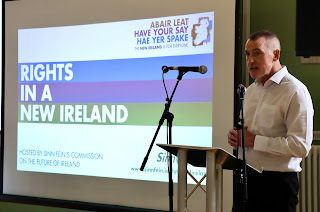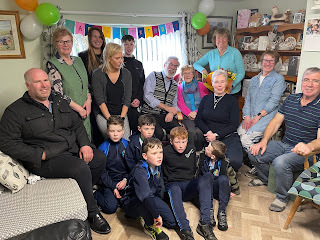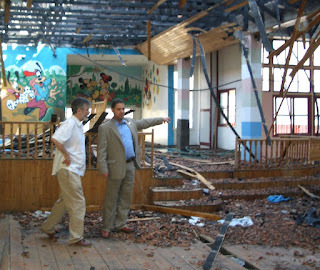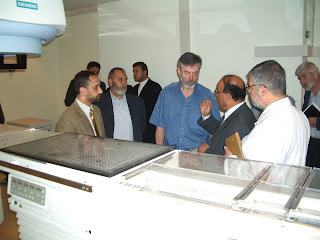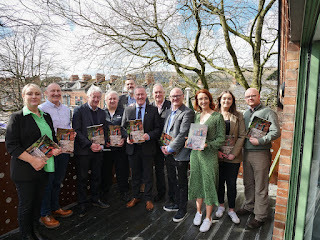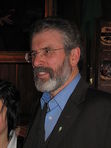Gerry Adams's Blog, page 7
July 1, 2024
NO PASARAN! | TOMMIE AND MICHEÁL
NO PASARAN!
Across Europe, in the USA, the Middle East and in England regressive political elements are gathering strength. In the North of Ireland we have always had to contend with these forces. And historically the right wing have played a significant role in our affairs across the island. They were well represented in the conservatism of the Catholic hierarchy which like its fundamentalist protestant counterparts in the North, had a privileged position for far too long. Everyone deserves full civil and religious rights. But no religious grouping should have the state to uphold its positions.
Fascists also emerged at different times. Cumann Na Gael – now Fine Gael – grew from the Blue Shirts. Today we live in more enlightened times but the Far Right and other right wing tendencies are raising their heads once again. They must be vigorously, peacefully and resolutely resisted by citizens and be subject also to the rule of law.
Racism and sectarianism are products and symptoms of colonialism and imperialism. They divide and conquer people by exploiting fears and insecurities especially in times of change. Ireland, which has suffered from colonialism, has a natural affinity with other colonised countries. It is no accident that Irish people are famously generous in our contributions to victims of famine and war, or for example in our support for the people of Palestine and other oppressed people. But not everyone in Ireland supports these positions.
The presence of people of a different skin colour or others who are obviously not local, in communities across the island discommodes some folks. Protests and arson are now not unusual. In Belfast loyalist paramilitaries intimidate these newcomers. But they also do the same with Catholics so those from that community who decry the presence of refugees need to consider the company they are keeping.
So too for those who accuse emigrants of taking homes away from the rest of us. Or of taking benefits and over stretching public services. Emigrants are not to blame for the housing crisis, North or South. That is the responsibility of those in government, particularly in Dublin. Simon Harris and Micheál Martin are to blame for the homeless crisis, not some unfortunate people fleeing death or destruction in other climes. And truth to tell, these poor people are not the threat to our public services. Again, that comes from Government policy, particularly privatisation and lack of funding. The reality is that our health services in particular could not function without workers from other countries.
But when people are getting it rough it is easy to understand why their fears can be exploited by right wing elements. People who have concerns about the unregulated influx of refugees into communities already under pressure are not necessarily racists. But the absence of coherent Government policy to offer refuge to those who deserve it has assisted the efforts of those who are racists. By such government incompetence are decent people sucked into racist behaviour.
Populist action by Simon Harris and Micheál Martin like the destruction of tents used by desperate homeless refugees will solve nothing in the longer term. Look at the shameful treatment of the Travelling Community for decades if an example of the unworthiness of that behaviour is needed.
No. What is required is a firm resolve to face down the right wingers while promoting and implementing progressive policies based on tolerance, equality, objective need and respect. And by actively building public services including social and affordable housing.
Equality and democracy are interdependent. If governments do not improve the social and economic well being and rights of all their people – what value does democracy hold for those people?
In such an unfair dispensation racists and right wingers will thrive. Our duty is to oppose them. To make sure that they shall not pass.
TOMMIE AND MICHEÁL.
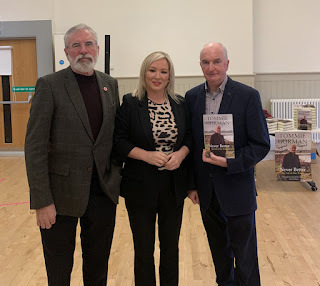
I was very shocked to hear of Tommie Gorman’s death. I had been with Tommie just two weeks before at an event in Dublin. He had already texted me to tell me his cancer was back. He told me as he always did that he was “Never better”. That was one of his little sayings, and the name of his book incidentally.
He said to me “it's ok”, it's no problem” and he gave me a hug. We had a yarn and subsequently we texted each other again after that. Approaching his operation I also reached out to wish him good luck.
I want to send my heartiest condolences to Ceara, Joe and Moya, to Tommi’s sister Mary and his brother Michael. He really missed his sister Paula who died recently also.
His death is a great loss to his family and to his friends. Mo comhbhrón leo.
Being from the North West Tommie knew Martin McGuinness & Pat Doherty before he knew me. I really only got to know him properly when he became RTEs northern editor. Our relationship started off pretty robustly. We had quite a few arguments off air but we settled down and I got to know him very well, though at times some of his broadcasts drove some republicans mad.
But there was also a little private side to Tommie where he stepped outside of his journalistic role and befriended people. This included people within the leadership of the DUP. He went about gently building bridges between the Sinn Féin leadership and that leadership.
He would come quietly and give me and Martin his view of what was going on. He was always positive and always trying to encourage and I'm sure he did the same thing with the DUP. Peter Robinson and Arlene Foster's presence along with Michelle O Neill and mé féin at his funeral is proof of that.
When we came to the point back in the day when Sinn Féin and the DUP got talking formally, Tommie had made sure that we already had some personal understanding of each other's positions. Tommie always said he wouldn't go public about any of this and he never did.
So I am pleased and proud to say that at the end of his life we were very good friends. That was part of Tommie’s character. He befriended people. He loved making connections.
He fought his cancer so bravely. He advocated for cancer sufferers.
He went at my request at times to talk to friends of mine who were diagnosed with cancer and he very gently gave them counselling and mentored them. No doubt he did this with others as well. He got many people onto a scheme for cancer treatment in Sweden which he also availed of. He was always helpful and was always prepared to go and help people.
Tommie loved RTE and Sligo Rovers. He loved Christy Moore. He loved the peace process.
Mícheál Ó Muircheartaigh and Tommie were buried on the same day. I listened to Micheáls funeral service on Raidió na Gaeltactha on my way to Tommie’s funeral in West Sligo.
My memories of Mícheál Ó Muircheartaigh are the same as everybody else who loves Gaelic games. It's that lilting, poetic West Kerry voice in and out of Irish and English telling the story, lyrically lifting the game beyond at times what was happening on the pitch. I used to love listening to his commentary on the radio.
Two things stick out in my head. He spoke at an event in Cork City Hall that I was speaking at about the future of Ireland. Mícheál chose to read a poem. It was a song by Paul Robeson called ‘My House’. It was to give his sense of the type of Ireland he wanted to see. That is a country with room in it for everyone.
Another memory is of Micheál reading ‘The Beautiful Game’ at young Tyrone Gael Cormac McAnallens funeral. He stood at Cormacs graveside and read this gorgeous poem on that sad day.
The Beautiful Game
Less than a minute remains on the clock,
As I tighten my lace and turn down my sock.
One last chance, and it's ALL down to me,
It must be a goal, for we need all three.
I step up to the ball and look towards the posts.
Is that the crowd I hear, or is it the ghosts
Of men who before me who have faced the same test,
And never once failed to give it their best.
My father he gave my the love of it all,
When he guided my arms to strike that first ball.
A hurley a football, its the same thing to me.
It’s playing the game that matters you see.
From boys in a field to a big crowd roar,
There’s never been anything to excite me more.
From the day I can’t walk,
And even then about the game I’ll still talk.
The few steps to the ball now seem like a mile,
But a well placed shot and I’ll be carried in style
On shoulders of team mates expressing their joy,
It's a dream that’s consumed me since I was a boy.
My feet pound the ground, my foot sends the ball,
It sails through the air over men who are tall.
Then dipping and curling, it finds the goal,
And just for a moment I’m in touch with my soul.
A whistle blows hard and I awake from my dream.
I’m watching my own son play for the team,
And but maybe one day they’ll announce HIS name
As he steps out to play - the beautiful game.- Brendan Kane
Ba guth na Gael Micheal. Glor Cumann Luath Cleas Ghea. Laoch. Fear usail. Éireannach agus Gaeilgeoir iontach. Mo comhbhrón leis a clann fosta agus a chairde. He was the best of who and what we are.
June 10, 2024
Candidatitis: Pathway to Change
Candidatitis
I first published this article in 2007 and then, slightly amended in2016, 2022 and last year’s local government elections in the North. There arefour elections across the island within the next 5 weeks. So I thought thiswould be a good time to republish Candidatitis again, slightly amended oncemore.
It is my tribute to the majority of candidates who won’t get elected.Good luck to them all. Good luck especially to Sinn Féin’s candidates. I hopewe have a great result. That’s all in the gift of the electorate. So I thankall the voters as well as all the candidates.
Opinion polls have become an integral part of every election campaign.Every newspaper and every broadcast outlet tries to second guess the electorateby commissioning polls. And then their columnists or pundits spend a hugeamount of time analysing the poll they just commissioned.
So do many candidates. And their supporters. This can lead to moodchanges and other character changing tendencies. This can be very stressful. Soevery candidate and everyone else should be mindful of the particular andpeculiar stresses and strains that come with being a candidate. It’s a form ofailment called Candidatitis. It begins with the candidate coming to believe –with a certainty known only to the prophets of old – that they are going towin.
This syndrome is capable of moving even the most rational aspirant orshy wallflower into a state of extreme self belief. It strikes without warning,is no respecter of gender, and can infect the lowly municipal hopeful, theaspiring Parliamentarian, as well as the lofty presidential wannabe.
I believe this is due to two factors. First of all most peoplestanding for election see little point in telling the voters that they are notgoing to win. That just wouldn’t make sense. Of course not. So they say theyare going to win.
That's when Candidatitis starts. As the 'we are going to win' isrepeated time and time again it starts to have a hypnotic effect on the personintoning the mantra.
Which brings me to the second factor. Most people encourageCandidatitis. Unintentionally. Not even the candidate’s best friend willsay hold on, you haven't a chance. Except for the media. But no candidatebelieves the media. And most candidates are never interviewed by the mediaanyway.
So a victim of Candidatitis will take succour from any friendly wordfrom any punter. Even a 'good luck' takes on new meaning and 'I won't forgetye' is akin to a full blooded endorsement.
So are we to pity sufferers of this ailment? Probably not.
They are mostly consenting adults, although some parties occasionallyrun conscripts. In the main these are staunch party people who are persuaded torun by more sinister elements who play on their loyalty and commitment. In somecases these reluctant candidates run on the understanding that they are notgoing to get elected. Their intervention, they are told, is to stop the votegoing elsewhere or to maintain the party's representative share of the vote. Insome cases this works. But in other cases, despite everything, our reluctanthero, or heroine, actually gets elected. A friend of mine was condemned toyears on Belfast City council when his election campaign went horribly wrong.He topped the poll.
That’s another problem in elections based on proportionalrepresentation. Topping the poll is a must for some candidates. But in PRelections such ambition creates a headache for party managers. If the aim is toget a panel of party representatives elected they all have to come in fairlyevenly. This requires meticulous negotiations to carve up constituencies.Implementing such arrangements make the implementation of the Good FridayAgreement look easy.
It means only placing posters and distributing leaflets in specificareas with clear instructions to the electorate on how we would like them tovote. In some elections I have noticed that some candidates (not Sinn Féincandidates folks) putting up posters in their colleagues territory. Not a goodsign.
It requires an inordinate amount of discipline on the candidates'behalf not to fall into this trap. Many do. Some don’t. Some get really sneaky.Particularly, as the day of reckoning comes closer. Panic attacks and anallergy to losing can lead to some sufferers poaching a colleague's votes. Thisis a very painful condition leading to serious outbreaks of nastiness andreprisals and recriminations if detected before polling day. It usually cannotbe treated and can have long term effects.
So dear readers all of this is by way of lifting the veil on theseproblems which infect our election contests. Politicians are a much malignedspecies. In some cases not without cause.
So the next time you look at a poster or get a leaflet through theletterbox or are confronted at your door by a wild eyed candidate –occasionally accompanied by a posse of cameras – then take a moretolerant and benign view of the sometimes strange behaviour of those citizenswho contest elections .
When you are accosted by a pamphlet waving candidate, as you shop inthe supermarket or collect the children at school or are minding your ownbusiness as you walk down the main street, try to see beyond the brashexterior. If they get carried away with themselves it’s not really their faultyou see. Big boys and big girls make them do it.
Most candidates are decent well meaning civic minded citizens. It’s a pity some have awful politics. So your votes should not encourage them.They will have difficulties enough dealing with defeat as well as theoutworking of Candidatitis But they will recover eventually.
If they get elected they or we may never recover. Please spare us fromthat.
Pathway to Change
Ireland’s Future has anevent in the SSE Arena in Belfast on Saturday 15 June. Entitled – Pathway toChange –it has all the makings of a seminal moment in our discussions about thefuture. It will be the largest gathering by Ireland’s Future since itsenormously successful ground breaking meeting in the 3 Arena in Dublin inOctober 2022.
Pathway to Change willbring together an impressive number of mainstream political and civic figuresfrom across the island of Ireland to discuss their vision of the future of ourisland. The list of notable speakers includes Alliance leader Naomi Long,SDLP MP Claire Hanna, Uachtarán Shinn Féin Mary Lou McDonald, former Allianceleader John Alderdice, Social Democrat leader Holly Cairns, Trade Unionist MickLynch, Labour Party leader Ivana Bacik, ProfessorBrendan O’Leary, Claire Mitchel, GAA President Jarlath Burns , LeasUachtarán Shinn Féin Michelle O’Neill, and veteran unionist and evangelicalProtestant Wallace Thompson will join Davy Adams and other panel guests.
WallaceThompson is a founding member of the DUP and in a recent interview on the BBC’s‘The View’ said that some fellow unionists share his view that a united Irelandis “inevitable”. He conceded that the previous positions of “no surrender” and“Ulster says No” got unionism nowhere and added: “The Union is damaged byBrexit. I can’t see it being repaired. We’re in danger of rearranging the deckchairson the Titanic.”
Whateverour different opinions might be on future constitutional arrangements thereality is that it is imperative that all of us who seek democratic changeengage in a positive and respectful dialogue with each other.
Thismeans planning for Irish Unity. It is important that unionists areinvolved in shaping this. The unionist population and its politicalrepresentatives need reassured that their cultural identity will beprotected in a new and independent Ireland.
It alsomeans that the Irish government must stop running away from this issue andprepare for the unity referendums that are coming and plan for a successfuloutcome. The Irish government should establish a Citizen’s Assembly tobegin this work of planning.
I commendIrelands Future for organising the SSE event. On 15 June I will join thethousands of others to listen and to learn. If you haven’t yet got your ticketyet then book now at the link below:
Irish Unity makes economic sense: “We are running out of words to describe what is happening in Gaza.” United Nations: A Better World Is Needed.
270524
Irish Unity makeseconomic sense
Last month a report bythe Institute of International and European Affairs (IIEA) caught the headlineswith the claim that Irish Unity could costthe South up to €20 billion annually. The analysis was quickly challengedby other economists and last week those with different opinions had theiropportunity to address the Oireachtas Committee on the Implementation of theGood Friday Agreement.
Professor John Doyle of Dublin City University wasjoined by Seamus McGuinness a Research Professor at the Economic andSocial Research Institute (ESRI) and by Dr. Adele Bergin who is also anAssociate Research Professor at the ESRI.
Professor Doyle told the Committee that the IIEAreport “is wildly inaccurate as the report contained significant errorsand is based entirely on unreasonable assumptions. Consequently the figuresreport not just the worst case scenario but they are completely wrong.” Heestimated that the initial cost to the South would be in the region of €2.5bn ayear. That is 2 percent of the current annual general governmentexpenditure.
John Doyle said that the IIEA report assumed thatpublic service salaries in the North would be immediately increased to levelsin the South in the first year. “This is unrealistic and unnecessary…Convergence will happen over time and will involve negotiations with publicsector trade unions. Merging salary levels over 15 years – half the time takenby Germany, would mean a cost of approximately €133m (£96.3m) in year one,rising on average by that amount each year."
Professor Doyle also told the Committeethat the IIEA study excluded any analysis of economic growth followingunity. He said, “It assumes that with the same political system, EUmembership, policy framework, education system and tax regime, that NI wouldnot economically converge with the South. This is a very unlikely outcome. Whywould Belfast perform so much worse than Cork and Kerry with the same EUaccess, policies, education and tax system?”
He also pointed out that the IIEA paper took noaccount of the additional taxes that would be raised from public sectorworkers.
Professor Séamus McGuinness and Dr Adele Burginfrom the ESRI made it clear that cost is not a barrier to Irish Unity. IrishUnity can be an economic opportunity North and South. What is needed is properplanning. The onus to lead that planning is with the government and theOireachtas but should involve experts, civil society and the public as a whole.
The Dublin government should establish across-party Oireachtas committee empowered to produce a Green Paper. Such aGreen Paper would research all of the key issues crucial to a future prosperousunited Ireland. This would provide much needed information about what a futureunited Ireland could look like and how it would work.
“We are running out of words to describe what ishappening in Gaza.” United Nations
Tuesday was a special day. For the first time thePalestinian flag flew over Leinster House in Dublin following the announcementby the government to formally recognise the State of Palestine. Tuesday’s movewas the next step in a process that will see the Palestinian Mission in Dublinupgraded to an Embassy. The representative office of the Irish government inRamallah will be re-designated as an Embassy and its representative there willbecome an Ambassador.
The Israeli government response to the decision bythe Irish state, Norway and Spain was to parade their three ambassadors infront of the Israeli media while forcing them to watch an Israeli film aboutOctober 7. Other Israeli Ministers also strongly rebuked the three governmentsaccusing them of aiding Hamas.
The reality of course is that Israel’s war aim ofdestroying Hamas has failed. It was never achievable. What is needed is a peaceprocess. And ceasefires to facilitate this.
Why has Israel reacted so vehemently to therecognition decision? Because it knows that the symbolism is hugelysignificant. It will provide more diplomatic and international avenues to thePalestinian people to hold Israel to account for its actions and it reinforcesthe very real sense of international isolation that the Netanyahu government isexperiencing at this time. The decision by the Irish state, Norway andSpain means that 146 United Nations member states out of 193 recognise thestate of Palestine. Seven European Union members have already taken thisstep - Bulgaria, Hungary, Poland, Romania, Slovakia, Sweden and Cyprus. WithSpain and the Irish state joining this list that means that one third of the EUstates now formally recognise Palestinian statehood. Every effort must be made,especially after the EU elections in June to get EU institutions torecognise Palestine.
As the Netanyahu government comesunder increasing criticism the decision by the International Criminal Court toseek arrest warrants for potential war crimes for Netanyahu and DefenceMinister Yoav Gallant, in addition to three Hamas leaders, has added toIsrael’s isolation. In addition, the United Nations International Court ofJustice last week ordered Israel to “immediately” halt its assault onRafah. Predictably Israel described the ICJ order as ‘false, outrageousand disgusting.’
Since then the Israeli assault onRafah and other parts of the Gaza strip has continued. On Sunday Israel bombeda tent city burning children and women alive. A bleak, desperate picture of thesituation was given in a briefing to the UN Security Council by Edem Wosornu, of the Office of the UN for the Coordination of Humanitarian Affairs (OCHA).She said: “To be frank, we are running out of words to describe what ishappening in Gaza. We have described it as a catastrophe, a nightmare, as hellon earth. It is all of these, and worse.”
The next short term steps areclear. The UN Secretary General António Guterres has confirmed that ICJdecisions are binding. The Irish government must now use its internationaldiplomatic services to secure support for a resolution at the UN which demandsan end to Israel’s genocidal war in Gaza; the release of all hostages –including the 6,000 held by Israel – and immediate humanitarian access for themountain of aid that Israel has blocked from Gaza. It also needs to demand thatthe EU institutions recognise the Palestinian state.
A Better World Is Needed.
For decades now I have argued thatthe big central international struggle of our time is for people to havedemocratic control over the decisions which affect their lives. The absence ofthis basic right underpins conflict in the Middle East and Ukraine and otherparts of the world. It poisons relations between Ireland and Britain andwithin Ireland although thankfully we have a process for dealing with that.Painfully slow though it is, it is better than war. And such an approach isclearly required in the Middle East and between Russia and Ukraine. Thatis what the United Nations should be advocating.
That means taking a stand for the emancipation ofhumankind from all objectionable political bonds imposed from outside. Selfdetermination is our starting point. That means independence of nations,starting with our own.
Despite Ireland’s historical neutrality, the Irishgovernment has incrementally moved to supporting the ‘security’ agenda of theworld’s bigger powers. That is why we need to enshrine a policy of positiveneutrality in the Irish Constitution. We should not join or form anyassociation with any military alliance and we should oppose the militarisationof the European Union.
The United Nations needs reformed. It needs to bemore democratic, particularly the composition of the Security Council. Properweight must be given to the majority of the world’s people. They want peace.They want an end to war everywhere. They want an end to world hunger. They wanteveryone to have access to food, clean water, and an end to deaths fromtreatable illnesses. They want an end to global warming and a focus on measuresto protect and enhance a clean healthy environment.
So international security needs to shift from apurely militaristic agenda, which attacks democratic rights and civilliberties. A security agenda which is based on repression and the promotion ofconservative right wing economic models favoured by the global elites is not goingto deliver true global security.
Abetter world is possible. It is also needed. For all our local distractions weneed never to lose sight of that.
May 20, 2024
Immigrants are not the enemy: Recognise the State of Palestine: The Bluebells are Back
Immigrantsare not the enemy.
Divide and conquer is an age oldtactic. It is often utilised by conservative elements to advance theirregressive agendas. This is true of the Irish as it is of any other nation. Infact historically some Irish people have acted against the interests of Irelandand supported imperialistic and other colonial or domestic adventurers. Nonetheless the vast majority of Irish people are fair minded, decent andprogressive.
At this time conservative and right wing elementsare exploiting the issue of asylum seekers and immigrants or race to advancetheir own agenda. They deliberately heighten the mistaken belief by some that‘outsiders’ are responsible for too few jobs, low wages, or a lack of housing,All of the ills of society are blamed on these ‘others’ who are of a differentethnicity or race or religion, colour or language or customs. Northern societysuffers to this day from divisions supposedly based on religious belief.Nowadays however many have come to understand that this is false. It issectarianism pure and simple, created and sustained to divide. So too with racism.Not everyone concerned about immigrants is a racist. But their fears arebeing whipped up by those who are.
The reality of course is that it is governmentsthat have responsibility for managing their societies and economies. If thereare not enough homes it is because the government is not planning for orbuilding them. It is not the fault of immigrants. But if there is a housingshortage and there is and immigrants are being accommodated - even in tents, itis easier to pick on them.
Today theright wing is at it again. Lies are being told and they are being aided in thisby the incompetence of a bad government in Dublin. A lack ofplanning or consultation with local communities and a failure to investadequate resources in communities affected has provided the right wing with theopportunity to raise tensions and fears. The government’s immigration policycan best be described as shambolic. It is not fit for purpose.
In recentweeks the Minister for Justice claimed that 80% of those applying for asylum inthe South are coming from Britain via the North. She has no evidence, nostatistics, no data to support this claim but the result is that the right wingand some of its allies in the political system and media demand that the borderbe re-imposed and checkpoints established.
Add thisto the lack of planning; the chaotic and very public mess by government offinding hotels or other accommodation. The recent removal of tents in Dublin -and let’s not forget that is how the Traveller community has been treated fordecades - is a disgrace.
What isneeded is an immigration policy that is rooted in the human values ofcompassion, fairness and friendship.
As MaryLou McDonald told the Oireachtas last week: “That means an immigrationsystem that is fair, efficient and enforced, and a system with common sensethat safeguards social cohesion and protects human rights. Both can be doneeffectively in parallel.”
Thereality is that public services North and South would collapse if it were notfor the many immigrants who have travelled to the island of Ireland in recentyears. Our hospitals, nursing homes, schools, transport system, retail sectorand much more would crumple without the new Irish. And they all pay their taxesand contribute to the well being of our society. Just like we Irish do in otherparts of the world.
Accordingto Migrant Rights Ireland:
· The South is in the top ten of states whosenationals emigrate to work.
· It has the second highest proportion of itspopulation living in other countries of the EU.
· International studies show that it will needmigrant workers to support an increasingly dependent population.
· The majority of migrant workers are of workingage and contribute more to the economy in taxes and PRSI than they receive inpublic services or social welfare.
· It has been estimated that migrants contribute€3.7 billion to the economy annually through taxes and PRSI, work permit fees,immigration registration fees, higher education fees and personal consumption.
· Migrant workers and their families contributeto society and their local communities.
Inaddition a report from the National Economic and Social Council (NESC)several years ago found that migrants help increase economic growth, easelabour market shortages, improve output and contribute to reducing earningsinequality. And Róisín Fitzpatrick, of Deloitte Ireland said in 2022 of theimpact of the pandemic: “The foreign nationals who have taken up thehealthcare assistant roles in nursing homes and care facilities since July 2021have allowed us to support and care for those most vulnerable in Irishsociety.”
So, weneed a fair and responsible, human rights compliant immigration system.Immigrants are not the enemy but those who promote hatred and divisioncertainly are.
There wasa time when it was the Irish, fleeing hunger, poverty and the repression andexploitation of British colonialism, who were marginalised, denigrated anddepicted as thuggish and ape-like. The diaspora that escaped to Britain, theUSA and elsewhere across the globe, especially after the great hunger, weretreated dreadfully in their new countries. We should never allow ourselves todo on to others what was done on to us.
Recognisethe State of Palestine
SinnFéin’s National Party Chairperson Declan Kearney MLA was in South Africa at theweekend where he spoke at the ‘Global Anti-Apartheid Conference onPalestine.’ The conference was attended by Palestinian groups. Whilethere Declan met with South Africa’s foreign minister and ANC MP Naledi Pandorwho has led the international condemnation of the Israeli state’s genocidal waragainst the Palestinian people. Declan also told Minister Pandor that Sinn Féinfully supports South Africa’s courageous case against Israel at theInternational Court of Justice.
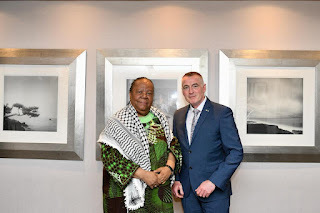 SinnFéin has had a close relationship with the African National Congress going backmany decades and we each have a long history of international solidarity,particularly in support of the right of the Palestinian people to national selfdetermination.
SinnFéin has had a close relationship with the African National Congress going backmany decades and we each have a long history of international solidarity,particularly in support of the right of the Palestinian people to national selfdetermination.
Also atthe weekend the assault by the Netanyahu government on Rafah has forcedhundreds of thousands of Palestinians to again tread the refugee path in theirown place. Over 35,000 Gazans, including 15,000 children, have now been killedwith many more bodies still under the rubble. Western governments, led by theUS and Britain, have refused to demand an immediate and permanent cessation,the release of all hostages (over 6,000 are held by Israel) and unrestrictedhumanitarian aid for the people of Gaza.
In themidst of this carnage the United Nations General Assembly last week took theimportant step of voting in favour of granting "new rights andprivileges" to the state of Palestine, creating a path toward fullUN-member status. Almost 150 countries voted in favour of upgrading Palestine'sstatus, with nine voting against and 25 abstentions. The resolution also callson the Security Council to reconsider the request for Palestine to become the194th member of the United Nations. When this last came before theSecurity Council in April it was vetoed by the United States.
Finally,in what could be a historic decision the EU'sHigh Representative for Foreign Affairs, Josep Borrell appeared to confirmIrish media reports that Ireland, Spain and other like-minded EU member statescould formally recognise the State of Palestine on 21 May. It should no longerbe conditional. It is long overdue especially for Ireland. The Irish governmentmust take this vitally important step and do what the Oireachtas voted for tenyears ago.
The Bluebells are Back
Comhgairdheasto all of those involved in the planning of Féile na gCloigíni Gorma – theBluebell Festival 2024. This is the eighth year of this wonderful event inBelfast’s Upper Springfield/Ballymurphy area. Féile includes mountain walks andtalks and poetry and music.
TheFestival will honour the dedication of visionary community activist Seán MacGoill whose name adorns the local Glór na Móna centre. Several weeks agofollowing his death I wrote about Seán. He was one of a band ofactivists who was centrally involved in the growth and development of the Irishlanguage in Belfast. The festival itself is a celebration of life and natureand of the contribution of the Black Mountain in the lives of the people of theUpper Springfield.
Itis on until this Saturday and a programme of the events can be foundhere: https://www.glornamona.com/wp-content/uploads/2024/04/FNAG_2024_Digital-2.pdf
Solidarity to Student Protesters: Captive Columns – an untold account of prison life: Rights in a New Ireland
Solidarity to Student Protesters
In the late 1960s the major national andinternational issues of the day that helped shape my politics were theanti-Vietnam War movement, the anti-apartheid struggle against the racist SouthAfrican government and the civil rights movement in the North. In allthree the activism of students was central to raising public awareness andopposition to injustice.
Today students are again at the heart of an ant-warmovement. In the USA students at over 100 university campuses have taken astand against the genocidal war of the Israeli government against thePalestinian people. In scenes reminiscent of anti-war demonstrations almost 60years ago the images of riot-clad and armed police brutally arresting over2,000 students, college professors and academics on US campuses has shockedmany. Film footage and photographs from 4 May 1970 of the shooting dead of fourstudents at Ohio Kent State University have been replayed again and again onsocial media as anti-war supporters express their opposition to what is nowtaking place in the USA.In Britain and Ireland and in parts of Europe, as well asin Canada, Australia and other states similar protests are now taking place atUniversities, including Trinity College in Dublin.The demands of the students are simple – a permanent end tothe war, the release of all hostages – including the 6,000 held by Israel – andfor universities to disinvest from Israel. Well done and thank you to all ofthose students taking part in these peaceful, non-violent protests.Captive Columns – an untold account of prisonlife
Cumann na Meirleach Poblachtach Éireannach/ TheIrish Republican Felons Association celebrated its 60th birthdaylast weekend.
The first part of last Friday evening’scelebrations was given over to Danny Morrison who hosted two conversations. Thefirst was with Síle Darragh and Mary Doyle and focussed on their experience inArmagh Women’s Prison. The second was with Colm Scullion, Jackie McMullan, andJazz McCann. This centred on Bobby Sands, Joe McDonnell and Kieran Doherty whothey knew well in the H-Blocks. The discussions were insightful, informativeand inspiring.
Afterward I was asked to introduce my good friendGino aka Eoghan Mac Cormac who has just published a new book ‘Captive Columns –an underground Prison Press 1865-2000’.
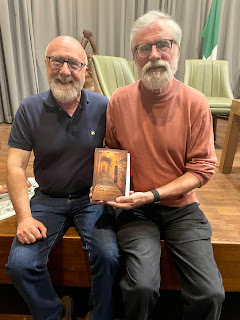 In all my dealings with Gino he has been verypositive, cheerful and funny. He is also very clever. Especially with words ínGaeilge agus Bearla. From cross word puzzles in the H-Blocks, to regular contributionsto our Irish Unity magazine Éire Nua – to designing republican jigsaws to hisrecent books of poetry and prose. He is the author of Cáibín an Phápa – a novelwritten during his final years in prison and Pluid which both won Oireachtasprizes. On the Blanket, Macallaí Cillín, the Pen behind the Wire, Gael agusGéibheann have also been published and now he has delivered ‘Captive Columns –an underground prison press 1865-2000’.
In all my dealings with Gino he has been verypositive, cheerful and funny. He is also very clever. Especially with words ínGaeilge agus Bearla. From cross word puzzles in the H-Blocks, to regular contributionsto our Irish Unity magazine Éire Nua – to designing republican jigsaws to hisrecent books of poetry and prose. He is the author of Cáibín an Phápa – a novelwritten during his final years in prison and Pluid which both won Oireachtasprizes. On the Blanket, Macallaí Cillín, the Pen behind the Wire, Gael agusGéibheann have also been published and now he has delivered ‘Captive Columns –an underground prison press 1865-2000’.
This new book published by Greenisland Presstells the extraordinary story of how republican prisoners, held in the mostdire of conditions, succeeded in circumventing the prison regimes to producenews-sheets and newspapers. Beginning in 1865 Gino has identified over 60 suchpublications. Sometimes they were single pages, single editions and whimsicalproductions. On other occasions these journals were thirty to forty pages inlength. Some were in English and others in Irish and occasionally they hadillustrations. They were all subject to the challenges of prison life – some foundduring searches – others subject to censorship, sudden transfers and sometimesexecution. That any survived at all is remarkable and often down to the cleverways in which copies were smuggled out of the prisons.
From the mid 19th century throughto the H-Blocks and Armagh in our own time toilet paper and prison prayer bookshave been the stable source of most of these publications. In the 1970s/80’sand 90’s cigarette papers were widely used.
But in his detailed research Gino brings us backto a young Cork Fenian John Sarsfield Casey who was transported to Australia in1867. He had already spent more than two years in prisons in Cork, Mountjoy andlater in Pentonville in Britain. In the latter the prison regime employed aseparation and silent system turning Pentonville into a huge silent tomb wherecommunication between prisoners was forbidden. Circular cages or rectangleswere constructed in the exercise yards and for 45 minutes each day the prisonercould walk without seeing another prisoner.
Casey later wrote; “plotting was the natural consequence of the isolation we were detainedin – necessity the mother of invention…Each prisoner is furnished weekly with asupply of brown tissue paper for WC purposes. Letters and words might be formedby pricking the paper with a needle and holding it between you and the light;the words then became quite intelligible.”
This was the just the beginning of asophisticated system involving republican prisoners recording their thoughts onscraps of paper and sharing them with comrades.
Gino’s book records the evolution of this processover 135 years through the Fenian prisoners held in English jails to the TanWar and Civil War, the 1930s, 40’s and 50s and then into our own period ofprison struggle beginning in 1969. It is an amazing story of human endeavour -of men and women overcoming adversity.
It is very fitting that Gino dedicated CaptiveColumns to Brian Campbell another great writer, editor of Scairt Amach, theCaptive Voice and An Phoblacht. I also want to reference Jazz McCann whoseparately from Gino wrote a book – ‘6,000 Days’ – which like Gino’s ‘On theBlanket’ details the brutality of the prison regime and the courage of theblanket men during that protest. It is a matter of wonderment to me that Jazzand Gino produced two very different accounts of unique, moving and evocativereflections and memories of a shared time in the same wing, at the same time.Both books are compelling and accessible story telling.
For me these two books exemplify the power of theimagination and memory and of the written word and the personal and individualunderstanding of events, personalities and personal experiences which areunique to the H Block Blanket protests. So too with Laurence McKeown’s ‘TimeShadows.’ There are other books about the Block. Armagh women like Síle Darraghand produced their accounts also and that is important.
‘Captive Columns’ is a work of important anddetailed research and scholarship of the highest order. It and the other booksI have mentioned are available in An Fhuiseog 55 Falls Road, BT12 4PD www.thelarkstone.ie; and online at www.sinnfeinbookshop.com
Lastweek the British government’s Legacy Act took effect and a group ofinternational human rights experts published a major report accusing theBritish state of operating a “systematic” practice of impunity to protect stateforces. In the same week people interested in human rights packed intoSt Comgall’s – Ionad Eileen Howell. The Conference was organised by SinnFéin’s Commission on the Future of Ireland.
The impressive panel waschaired by Ailbhe Smyth, campaignerand activist and included Dr Shannonbrooke Murphy Associate Professor in Human Rights at St Thomas University inCanada; Colin Harvey, Professorof Human Rights Law in the School of Law, Queen’s University and Daniel Holder,Director of the Committee on the Administration of Justice.
The contribution of panellists and audiencemembers clearly identified the need to put in place strategies thatpromote understanding. These must include a robust, internationally complianthuman rights system of laws and governance that incorporate rights, freedoms andresponsibilities; that guarantee civil and political rights; democratic,social, economic and cultural rights; children’s rights; language and culturalrights; environmental and developmental rights.
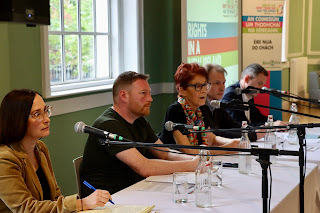 The Tories have spent 13 years eroding theprotections of the Good Friday Agreement. As a result there is No Bill ofRights; No Civic Forum in the North; No all-Ireland Civic Forum; No North-SouthCommittee of the two human rights commissions and No all-Ireland Charter ofRights. Clearly, there are many challenges ahead to undo these decisions. Bepart of this conversation. Reach out to others. The people of this islanddeserve a citizen centred, rights based society. London won’t give us this.Self-determination will if those of us who want real change plan for it. Thatis what last week’s conference was about. Be part of it.
The Tories have spent 13 years eroding theprotections of the Good Friday Agreement. As a result there is No Bill ofRights; No Civic Forum in the North; No all-Ireland Civic Forum; No North-SouthCommittee of the two human rights commissions and No all-Ireland Charter ofRights. Clearly, there are many challenges ahead to undo these decisions. Bepart of this conversation. Reach out to others. The people of this islanddeserve a citizen centred, rights based society. London won’t give us this.Self-determination will if those of us who want real change plan for it. Thatis what last week’s conference was about. Be part of it.
A video of the conference is available at https://youtu.be/wT4lj94yHjE
A successful conference in support of Moore St: Mass graves an act of barbarism
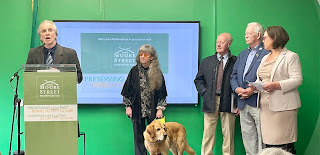
A successful conference in support ofMoore St.
Last week The Moore StreetPreservation Trust and Uachtarán Shinn Féin Mary Lou McDonald organised aconference to support the development of a Historical 1916 Cultural Quarter inDublin City centre with Moore Street at its heart.
The conference was uniquely held inthe GPO in Dublin on 24 April, the date on which the Rising commenced in 1916.It was from that location at the end of Easter Week that several hundredVolunteers, led by five of the leaders, evacuated the burning GPO to MooreSt. This area is at the heart of our fight for freedom. 16 MooreStreet was the last HQ of the 1916 government of the Irish Republic.
It was in the buildings, streets andlaneways surrounding Moore Street that the Irish Republic was born and where itwas defended for six days by heroic patriots who believed in a better future.
The packed meeting of business andretail people, local traders and Save Moore St activists, as well as Relativesof the 1916 leaders heard contributions from a range of speakers including SeánAntóin Ó Muirí the architect who designed the alternative plan for the MooreSt. Preservation Trust. Seán’s presentation gave us a sense of what ispossible.
Uachtarán Shinn Féin Mary LouMcDonald who hosted the event in association with the Moore St. PreservationTrust, spoke of the ‘ambitious vision’ that the Relatives and the Trusthave for Moore St. She said: “The Master Plan presented by the MooreStreet Preservation Trust is a plan that weaves together much needed housing,retail, and cultural experiences throughout the historical quarter. It’s framedby the idea of the ‘economic of uniqueness’ whereby city centre cores arerevitalised through investment in the unique historical and culturalcharacteristics of a city to create compelling experiences.
This modern approach is driving theregeneration of city centres across the world - creating jobs, delivering newopportunities, fostering social progress and empowerment, and growing localeconomies and tourism sectors in a resilient and sustainable way. This iswhat Dublin needs, and it’s all possible, all achievable.”
The opening contribution was by LizGillis historian and James Connolly Heron, great grandson of James Connolly.The two spoke of the importance of Moore St and cited the campaign to saveKilmainham Jail. Over the centuries that prison held hundreds of republicanprisoners through a succession of rebellions. It was there in May 1916 that 14of the leaders, including the five who had been in Moore St, were executed byBritish firing squads. In the 1930s there were plans to demolish the buildingwhich remained empty and derelict until the establishment ofthe Kilmainham Gaol Restoration Committee in 1958. Hundreds of volunteerworkers persevered for years following 1960 to replace the roof and protect thebuildings. If it had been left to the government Kilmainham Prison would havedeteriorated beyond repair. Today it is the second most popular visitorattraction on the island of Ireland and is among the top ten museums in theworld.
For Liz Gillis and James ConnollyHeron the lesson of Kilmainham is especially pertinent to Moore St.
Professor Terry Stevens is aninternational tourism expert who works with the United Nations in destinationdevelopment. In his contribution he described Moore St as a “unique andremarkable” project that can “deliver something very special to the story ofIreland and to Dublin” and can “enhance the overall appeal of your capitalcity.”
It was a point made time and again inthe course of the conference by local and international contributors.
Paddy Cullivan is a musician,presenter, historian, comedian and all round entertainer whose successful oneman shows on historical characters like Michael Collins and Wolfe Tone are funny,insightful and reveal much about our history that others have sought to reviseand hide.
With the use of photographs hereminded us of the many iconic buildings – Carlow Jail, Kilkenny Workhouse,Frascati House - and other locations from our past that have been swept away bydevelopers and planners to be replaced mostly by shopping centres and hotels.He reminded us that the greed of some has destroyed important parts of ourimportant historical infrastructure.
Clearly the people of Dublin andIreland will be better served by Seán Antóin Ó Muirí’s proposal andplan for Moore Street than the developers proposal to demolish this battlefield site. If properly developed this unique initiative will generatejobs and income alongside a sense of pride and respect for the men and women of1916.
Michael Murphy is an architecturaldesigner, educator and writer. He designed the National Memorial for Peaceand Justice in Montgomery Alabama which includes the National LynchingMemorial. It is a striking monument which commemorates a dark time in UShistory but which has also significantly contributed to the economicregeneration of Montgomery. Michael flew in from Boston to support The Trust’splan.
Others who contributed to a verysuccessful day were Stephen Troy a fifth generation butcher on Moore St, HarryConnolly from Fáilte Feirste Thiar, Caroline Alwright a fourth generationmarket stall owner and Jean McCabe of Retail Excellence Ireland.
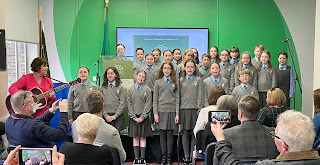 All in all it was a hugelyinformative day. The choir from Gaelscoil Coláiste Mhuire sang a rousingversion of ‘Óró, sé dobheatha abhaile’ and Uachtarán Mary LouMcDonald called on the government to “withdraw its backing for theHammerson plan and instead throw its weight fully behind the vision for MooreStreet as set out by the Moore Street Preservation Trust. It should alsoprogress and action the Ceathrú Chultúir 1916 Bill drafted by Aengus Ó Snodaighand passed unanimously by the Dáil in 2021.”
All in all it was a hugelyinformative day. The choir from Gaelscoil Coláiste Mhuire sang a rousingversion of ‘Óró, sé dobheatha abhaile’ and Uachtarán Mary LouMcDonald called on the government to “withdraw its backing for theHammerson plan and instead throw its weight fully behind the vision for MooreStreet as set out by the Moore Street Preservation Trust. It should alsoprogress and action the Ceathrú Chultúir 1916 Bill drafted by Aengus Ó Snodaighand passed unanimously by the Dáil in 2021.”
Her comments were echoed by JamesConnolly Heron and the Relatives of the Signatories who attended the conferenceand by the Preservation Trust. In a statement at the end of the conference andin a letter to An Taoiseach Simon Harris, James Connolly Heron advocatedthe alternative plan, and asked for a meeting with Mr. Harris “to present thealternative plan to you in person at the earliest opportunity. We believethat a meeting with you to discuss this alternative vision for Dublin Centralwill be of benefit in progressing a plan that will have the support of allinterested parties.”
It’s now over to An Taoiseach.
Mass graves an act of barbarism
Atthe weekend Leas Uachtarán Michelle O’Neill was in London to address amassive pro-Palestinian march. She described what is happening in Gaza as the“gravest human rights violation of our time.” Michelle called for "an immediate, unconditional andcomplete ceasefire. We need to see an end to genocide, ethnic cleansing,and collective punishment. All hostages should be released immediately and allaid for Gaza must be delivered immediately, and Israeli forces must withdrawfrom Gaza and the West Bank.”
Her call follows on the devastating reports thatmass graves have been found at two hospitals, Nasser and al-Shifa inthe Gaza Strip containing the bodies of 400 women, children and the elderly, aswell as doctors and nurses. Many had their hands tied and some were buriedalive. They were all executed by the Israeli military.
The Falls
I love photographs. Especially old photos. Particularly blackand white ones. Bill Kirk is a veteran photographer. The Falls ishis most recent collection, some twenty years after Images ofBelfast. It captures a time and a neighbourhood which has gone. AsRobin Livingstone in the Foreword says, ‘It is avital and compelling historical archive, describing in rich detail the peopleand places where the latest conflict in the shared and troubled history ofIreland and Britain took place.’
Well done Bill Kirk and Frankie Quinn, Director of the Belfast ArchiveProject. I really enjoyed trawling through Bill’s images, spotting old friendsand associates as well as places where I spent my childhood.I wholeheartedly recommend THE FALLS.
THE FALLSis availible from An Fhuiseoig, Falls Road.
It time to recognise the State of Palestine: Seán Mackel and the County Antrim Memorial. : Rights in a New Ireland
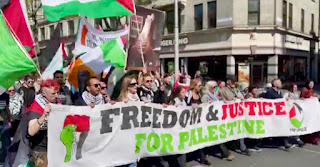
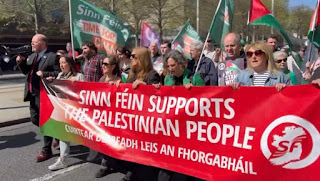
It time to recognise the State of Palestine
In 2014 Sinn Féin brought forward a Dáil motioncalling on the government to “officially recognise the State of Palestine, onthe basis of the 1967 borders with East Jerusalem as the capital …”
I was part of this initiative.It got support from other TDs from other parties and none. It was notopposed by the Government at that time. Following atwo day debate the motion was passed.This meant that ten years ago both Houses of the Oireachtas supported the rightof the Palestinian people to self-determination - to a Palestinian state. Thiswas a positive development. TheGovernment should have acted on this imperative. It refused to do so. I raisedthis refusal regularly with successive Taoisigh.
Every Taoiseach sincethen refused to deliver on the will and direction of theOireachtas. They would not act on this imperative. Instead they argued thatrecognition of a Palestinian state remained contingent on adeal with Israel to a two state solution. In reality Enda Kenny, Micheál Martin, Leo Varadkar gave the state of Israela veto over the right of the Palestinian people to a Palestinian state.
Today, according to Simon Harris and Micheál Martin, formaldiplomatic recognition of Palestinian statehood is now dependent on thecompletion of international discussions involving the Irish government. Is thisa real commitment to recognition in the short term? Or is the Irish government’s recognition of the state ofPalestine now conditional on the outcome ofinternational discussions about which few details have been given?
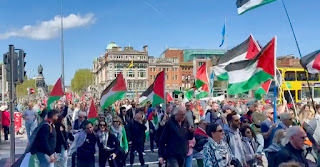 The motion passedby by the Dáil ten years ago was detailed and definitive.It followed an initiative by over 900 prominent Israelicitizens, including Nobel laureates, writers, academics, business people, andbroadcasters. They wrote toParliamentarians across Europe, including the Dáil, seeking support for aPalestinian state. The letter was evidence of a deep desire and hope bysome Israelis to adopt an approach which they believe is in the interests ofPalestinians but crucially is also in the interests of Israel.
The motion passedby by the Dáil ten years ago was detailed and definitive.It followed an initiative by over 900 prominent Israelicitizens, including Nobel laureates, writers, academics, business people, andbroadcasters. They wrote toParliamentarians across Europe, including the Dáil, seeking support for aPalestinian state. The letter was evidence of a deep desire and hope bysome Israelis to adopt an approach which they believe is in the interests ofPalestinians but crucially is also in the interests of Israel.
Days earlier I had been in Palestine and Israelwhere among those I spoke to was – Yehuda Shaul –a former Sergeant andCommander in the Israeli Army. He is a founder and co-director of ‘Breaking theSilence’ an organisation made up of former Israeli soldiers who speak outagainst the actions of the IDF. A role he continues with today. In 2014 inwords prescient of the current genocide and of the approach of theinternational community Shaul told me; “The International community isfailing Israelis and Palestinians. There is a lot of talk but no action.Nowhere in history,’ he said, ‘did people wake up one morningand give up their privileges... the international community has to raise theprice for Israel of the current status quo… No one will live in dignity orfreedom here. Neither the Palestinians or Israelis until there is a sovereignPalestinian state. This is the right patriotic position.”
The formal diplomatic recognition of thePalestinian State cannot forever be conditional on what others may or may notdo. Either the people of Palestine have national democratic rights or theydon’t. If they have the right to self-determination – and I believe theydo and more importantly the Dáilhas decided this – then there should be no more delays. Ten years is too long.
Tánaiste Micheál Martin several weeks agoacknowledged that many in the international community now accept thatrecognition of a Palestinian state cannot be contingent on a two state peacedeal. He and An Taoiseach now needto act on the logic of that position. TheIrish government should formally recognise Palestine as the rightful state of thePalestinian people. Perhapsif this had happened as it should have ten years ago the people of the MiddleEast might have been spared the awfulness of what has occurred sincethen.
Perhaps if they act now theprospect of wider conflict in the Middle East might be avoided. Or at least analternative leading to a meaningful peace process can be started.
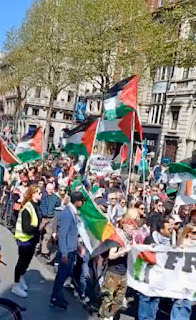
Seán Mackel and the County Antrim Memorial.
Following my tribute last week to Seán Mackel DrTom Hartley has written to me about Seán’s role in designing the County AntrimMemorial in Milltown Cemetery. This memorial is under the care ofthe National Graves Association, Belfast. There are thirty four IRA Volunteersburied in this plot. It was originally called the Tom Williams plot, becausemoney raised by the Tom Williams Gaelic Athletic and Camogie club bought theplot. The club was founded by republican prisoners in A Wing, Crumlin Road Jailwho wanted to reserve a grave in this plot for the remains of TomWilliams, a young republican hanged in Crumlin Road Jail in 1942.
The plot has two distinct sections. The mainsection has a cruciform monument. The smaller section to the immediateleft of the main section contains four graves with a grey stone slab on eachgrave. The original monument in the main section was designed by Sean Mackeland was made from Irish limestone. The bronze figures on the monument were bythe Dublin Sculptor Richard Edna King. On the reverse of the monument was arepresentation of Roisin Dubh calling on the republicans of Antrim to strikefor their freedom.
The front of the stone carries a male figuresymbolising breaking the bars of imprisonment and rising to freedom. One faceof the stone carried the names of Antrim’s patriot dead in the years 1798 to1803. Another face has names from 1867 to 1953. The front faces of the stonecarries names beginning in 1922 continuing through to 1971. The list on otherfaces carries through to 1990.
For many years a small stone on the right of themonument carried an inscription in memory of those Irish republicans who foughtagainst fascism during the Spanish Civil War. A black polished marble slab infront of the monument has eighteen names of republican volunteers buried inthis plot. The original monument was unveiled on Sunday, 11 September 1966. Anew stone was dedicated on Easter Sunday 2012. The plot is contained within agrey stone surround with railings.
Thank you Tom. Another slice of our history and afurther insight into Seán Mackel’s role. Many thanks also to BelfastNational Graves for their outstanding work. They and others throughout Irelandand the world take care of the graves of our patriot dead. Míle buiochasdaoibhse go leir.
Rights in a New Ireland
The issue of rights is at the heart of theconversation on a new Ireland. Sinn Féin’s Commission on the Future of Irelandwhich has been holding successful Peoples Assemblies across the island over thelast 18 months, will host ‘Rights in a New Ireland’ on Friday 3rdMay,in St Comgall’s – Ionad Eileen Howell, Divis Street, between 11.00am –1.00pm
If you are interested in human rights and want tohave your say on the future shape of a new Ireland join us in St Comgall’s– Ionad Eileen Howell on 3 May.
Expanding the debate on Unity: Celebrating 100 years: Keep supporting Palestinian people: Seán Mackel
Expanding the debate on Unity
A recent report - "Northern IrelandSubvention: Possible Unification Effects" - published bythe Institute of International and European Affairs (IIEA) caught theheadlines. It contained the startling claim that Irish Unity could cost theSouth up to €20 billion annually. It was grist to the mill of those who opposeunity.
Before the day was out contrary andcritical opinions of the report began to emerge with other senior economistscriticising it for its failure to acknowledge that a united Ireland will nothave responsibility for much of the subvention and that the amounts involvedare significantly smaller.
Whatever one’s view of the meritsof the IIEA report it succeeded in creating a debate around the shape of afuture economy for the island of Ireland and that is a good thing. Ithighlighted the absence of any planning by the Irish government and reinforcedthe call for a Citizens’ Assembly to discuss future constitutionalarrangements.
In a further contribution to theconversation around the future shape of a united Ireland Sinn Féin last weekpublished its latest policy document aimed at tackling division and segregationin society. ‘A New Ireland for all: Ending Sectarian Segregation’. Itsobjective is a shared society in which all citizens are cherished, respectedand protected in a new national constitutional democracy. Among thecontributors to the launch was Denzil McDaniel, former editor of the ImpartialReporter in Fermanagh and political commentator.
He told the audience in St.Comgall’s/Eileen Howell Ionad that; “There is a momentum building in thediscourse about a new Ireland, about the economy, what a health service or theeducation system would look like. These are all important conversations, andI’m not ignoring them; nor indeed the new Taoiseach Simon Harris’sdisappointing start in continuing the Southern Government’s failure to embrace theconversation.
But, specific this policy launch isabout ending sectarianism and segregation and that is vital in building abetter society. Small conversations about the kind of shared society we want tolive in and pass on to our children, and grandchildren, are important.Conversations about breaking down barriers, building trust, buildingrelationships are crucial. I was talking to a Protestant friend recently aboutwhat reconciliation really means and he later sent me this definition.
At its simplest, it means finding a way to livealongside former enemies - not necessarily to love them, or forgive them, orforget the past in any way, but to coexist with them, to develop the degree ofcooperation necessary to share our society with them, so that we all havebetter lives together than we have had separately.”
The new policy document is available at: https://vote.sinnfein.ie/need-for-step-change-to-tackle-sectarianism-and-build-better-future-oneill/
Last week I travelled to South Armagh with a large bunchof flowers to join the family of Maisie Moley in celebrating her 100th birthday.Maisie is a fresh, sprightly centenarian – the matriarch of the large Moleyfamily. She and they were in great form as we pushed back the furniturefor the obligatory photographs and all joined in the singing of Lá BreitheShona Duit.
The last time I was at the Moley household was in March1988 when Martin McGuinness and I carried the remains of her son IRA VolunteerBrendan Moley from the family home to his funeral with his comrade VolunteerBrendan Burns. Both had been killed in an explosion. I remembered all of thatas I drove along the narrow country roads and the South Armagh hilltops oneither side of us.
Well done Maisie. Happy 100 birthday to you.
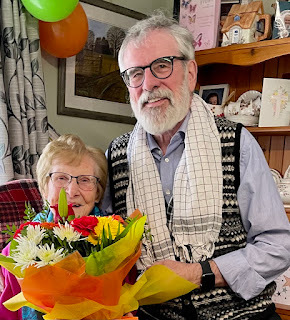
Keep supporting Palestinian people
As the world holds its breathwaiting on the outcome of the current face-off between Iran and Israel and thepotential for a regional war, the slaughter of innocents continues in the Gazastrip and on the west Bann.
Two weeks ago Israel destroyed partof the Iranian consulate in the Syrian Capital of Damascus. Senior Iranianofficials were killed. Last weekend, after giving a 72 hour warning of itsintention to respond, several hundred drones and missiles were launched by Iranagainst military targets in Israel. Iran has said that it has now concluded itsresponse. But has Israel?
In the meantime the Israeligenocide against the Palestinian people continues. Pogroms against Palestinianvillages in the west Bank are increasing and hunger has already claimedPalestinian lives, mainly of children. All of this increases the need forus to keep supporting the Palestinian people.
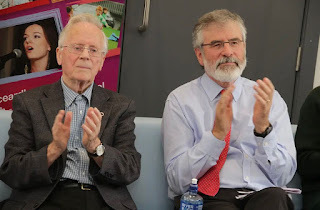
Seán Mackel
Seán Mackel died peacefullyin his sleep on 6th April. He was ninety one years old. Seán was thebeloved husband of the late Phyllis and loving father to Ciarán, Seán, Pádraig andÁine. He was father-in-law of Cathy, Susanne, Kate and the late Robert. Hewas also a much loved Grandfather and Great Grandfather. His family andfriends, including Jim Gibney and me gathered at St Patrick’s Church Saul in County Down for his funeral on April9th.
We are all the lesser for hispassing. Especially his family and his generation ofactivists. Go ndéana Dia trócaire ar a nanam uasal. Seánsson, Ciarán, put it well in his eulogy when he said
“Seán’s life was blessed withlove and sacrifice. And, as his children and grandchildren, we havebeen blessed with joy and love. As a community, we have gained fromhis vision, and resoluteness, and been emboldened by his courage and strongcharacter in the face of threat, persecution, and refusal. We arebroken-hearted at his loss, full of sorrow and grief, but united in ourcelebration of his life, and humbled and enriched by his legacy of practicalcontributions to our community.”
That phrase ‘practicalcontributions to our community’ sum up Seán’s activism for me. He was also aprogressive Catholic, a do-er, a gentleman, a Christian and an Irishpatriot.
Seán was born in 1933 and raisedin Servia Street, Falls Road and in Britton’s Parade in the Whiterock.Seán’s mother Josephine died when he was sixteen, with the youngestof the nine siblings only four years old. Geordie, their father,raised his children on his own, supported by Seán, and older sisters Maureenand Nora.
Seán was educated in St Kevin’sprimary school, and then in St Malachy’s. He went on to become anarchitect. Seán and Phyllis were married in 1954, and they lived for ashort period in Ligoniel and then Andersonstown, where they raisedtheir four children.
Seán Mac Goill is one of that bandof visionaries and activists which gave us the new Bombay Street after theoriginal Bombay Street was destroyed in the 1969 pogroms, the urban Gaeltachton Bóthar Seoighe, Ballymurphy Enterprises, The Andersontown News, the Whiterock Industrial Estate, Garáiste an Phobail, TheRockKnitwear Group and many other projects going backto the mid 1960s. Seán and his peers and their pioneering families were also immersedin the Irish language in West Belfast and the wider cultural revolution acrossthe city.
Have no doubtsabout their achievements. This is a hugely successful group of progressive Irish men andwomen. Theypersisted. And they prevailed. And we all benefitted. They created the structures for education, employment, progress, andself help despite fierce opposition from an actively hostile unionist andBritish regime. None ofthose involved benefitted personally from these initatives.
When theassets of the Industrial Estate – which was taken over by the British Army in1979 – were liquidised the proceeds went to Irish language projects, includingthe new Naíscoil an tSéibhe Dhuibh.
SeanMackle was a very practical activist. He told me once that we needed to replacenames of buildings and project with Irish names. ‘Dontuse the English translation. Use only the Irish and thats what people will use also’. He cited AnCumann Chluain Ard and the old Ard Scoil as examples of this. He said Sinn Féinshould have done that with Connolly House and of course he’s right.
AnChultúrlann is a good example of Sean’s philosophy. So is Féile An Phobail.
An evenolder example is the name Sinn Féin. Gael Ionad MhicGioll, in Ballymurphy, is named after Seán. Itis fitting that plans to expand this facility are well advanced at thistime.
Seán was a champion of self-helpand co-operative enterprises. He got things done. He and hiscompatriots made things happen. Déan é, na h-abair é – don’t justsay it, do it was their mantra.
Phyllis and Seán moved toDownpatrick in 1988. His work on Irish language developmentcontinued and he worked for many years for Iontaobhas na Gaelscolaíochta,supporting new and emerging Gaelscoileann. Seán remains inspirational tolanguage and community activists.
Gael go smior,is flaithiúil. Ní bheidh a leithid ann arís.
Go ndéana Dia trócaire air, issuamhneas síoraí ar a anam dílís.
If you want to learn more aboutthese mighty men an women and especially about Seán I am recommendingthe book Togáil Croí. Seán Mac Goill edited by Seán Misteal. It is availible from An Ceathrú Póílí, AnCulturlann. Bothar na bhFál, Belfast.
Up Antrim!: The Glory of Gaelic: Hurling: Lá Breithe Shona Duit Abdullah Ócalan: Six months of Hell
Up Antrim!
24 yearsago I wrote a short piece for Antrim 2000. I discoveredit this week when I was clearingout threedecades of accumulated books, newspaper clippings andassorted pamphlets. The 2000 reflection on Gaelic games isreproduced below. Since then much has changed in the Gaeldom. Themost important change is probably the growth of womens football. Until recenttimes women were confined to Camogie. Now Ladies Football is the fastestgrowing Gaelic game.
I look forwardto the outworkings of the Steering Committee for Integration chaired byMary McAleese. 2027 has been revealed as the year that the GAA , the CamogieAssociation and The Ladies Gaelic Football Association will come together asone. More needs done in the meantime to give womenGaels parity with their male contemporaries.
2027 will alsosee the emergence of the new Casement stadium. Anotherpositive.
Televisioncoverage has improved also. Mighty work is being done by punditsincluding some great podcasts and local print media columns. The BBCas a public service has more to do to bring in parity with other sports. Somecounty club finals have capacity attendances. That needs reflected incoverage. The RTE blockage of northern access to some fixtures isdownright insulting. So too with the lack of local Council playingfacilities. There is much more to be done by all concerned.
In Belfasthurling remains under pressure. Country clubs continue to stay ahead of cityhurlers. That’s to their credit. This is despite the mightywork of Gaels at all levels of the Association in Belfast.
Localclubs and their legions of voluntary helpers, committees, players,coaches,mentors, fundraisers and supporters remain the back bone of the Gaeldomacross the county, the nation and the diaspora. Our county boards do mightywork. So do local schools including Colaiste Feirste which is progressingnicely. Connections between schools, clubs and county will pay dividends indeveloping our player base.
We are lucky tohave such a living popular tradition. Last Friday’s Late Late Showwas a great celebration of this and a fitting testimony to An Cumann LuathcleasGheal as more than sporting organisation. It is a family. It isus at our best.
There was a timewhen Irish culture, including our games, was banned. In our own timecarrying a hurling stick in Belfast was illegal. So the last twenty five yearsof gaelic games have been amazing. We can look to the next twenty five yearswith confidence.
The Glor y Of Gaelic 2000.
“My first love is hurling. Thatincludes Camogie. Although there are those who will argue that the camógs playa different game. I think they play a better game. Then comes football which ismainly a kind of sport to keep hurlers fit. Handball is much under-rated and Iam too out of condition now to even think of competing, though I know some agedBelfast men who are still up to championship standard.
Recently, I was told, though I can’tvouch for this, that rounders is also a Gaelic game. Maybe some of your readerscould confirm this.
So what does it all mean? Howimportant are Gaelic games? What part do they play in our lives?
To suggest that one particular sportis better than another simply because it is a native game borders onxenophobia. So, Gaelic games are not necessarily better than other games simplybecause they are Gaelic. They are better simply because they are better.
Soccer is a pedestrian sport, hypedby big money, more entertainment than athleticism. An odd time you would see agood match. Rugby isn’t too bad. In fact it can be very good and I wouldn’tmind getting more time to learn about it. Croquet and tennis and ice skatingare okay so far as they go but they are not exactly team sports. Golfing isless elitist than it used to be and I presume that even bad hurlers could begood golfers and that a half decent hurler could be a great golfer. TigerWoods’ people come from Dunloy.
There is merit in all sport and Ican’t think of one that I would be against. Not on principle anyway thoughpoorly managed boxers battering each other’s brain out has never appealed tome. At the same time Muhammad Ali is one of my sporting icons. Him and SamboMcNaughton.
Cricket is popular in Derry City. Theleast said about that the better. It just goes to show that everyone has theirown taste. And that is how it should be.
But Gaelic games are special not onlybecause of their skills, the degree of athleticism, team work and sheercommitment involved. In this context even a sceptic would concede that theycompare favourably with any other sport and a neutral would agree that theyoutclass all alternatives. I know other ball players who have been amazed athow far and how accurately a senior footballer can kick a dead ball and hurlingstill bewilders visitors from other disciplines.
But Gaelic games are special becausethey are firmly rooted in local communities and open to all who support theGaelic code. Because they bring drama and excitement, craic and huge enjoymentto players and spectators alike. Because everyone can be an expert. Becausethey are part of what we are. Uniquely Irish. No better on that basis thananyone else but special nonetheless.”
Hurling
Antrim in Cú Chullain mode
Cheers me up
On the long road home.
Hurling is the victor.
Losing is no shame.
The joy is in playing
This warriors’ game.
LáBreithe ShonaDuit Abdullah Ócalan
The Good Friday Agreement was 26 years old on Wednesday, 10 April.For almost all of that time Abdullah Öcalan, a founder of the KurdistanWorker’s Party, has been in prison in Turkey. There is a mural to Abdullah onthe international wall in Northumberland St. April 4 was his75th birthday.
Held in solitary confinement for years, denied family visits for much ofthat time, he has nonetheless become a voice for peace, a leader willing tooffer the hand of friendship to enemies.
There arealternative ways to resolve long-standing differences. It takespatience and leadership.
Öcalan has demonstrated that leadership. Despite incarceration, hehas forged a road map to peace that commits the Kurdish people to democracy andfreedom and tolerance. He has said that it is time to “silence the weapons andlet the ideas and politics speak.” Öcalanwants a “new beginning” that willbring the Kurdish people’s struggle into a new phase in which they can throughnegotiation create an equal, free and democratic country for “all peoples andcultures.”
I commend Abdullah for his leadership and vision and urge the Turkishgovernment to release him.
Six months of Hell
This week marks six months from theattack by Hamas on southern Israel and Israel’s vengeful genocidal response tothat. October 7 was wrong but it didn’thappen in a vacuum.
Since 1948 when Palestine wasforcibly partitioned and three quarters of a million Palestinians were forcedto flee their homes, the Israeli state has further occupied the west Bank, fora time the Gaza Strip, built illegal settlements on Palestinian land andimposed a brutal apartheid regime.
In the decades since then scores ofresolutions condemning Israeli behaviour have been passed by the UN SecurityCouncil and General Assembly. Israel has ignored them all.
Six months on almost 35,000Palestinians, including 15,000 children, have been killed by Israeli bombs andsnipers and now by starvation. Scores of UN aid workers and now several foreignaid workers have been targeted and killed. Rafah remains under threat. Inaddition, Israeli forces attack Southern Lebanon and last week bombed theIranian Consulate in Damascus. These actions have increased concern that Netanyahuis trying to provoke a wider war to bolster his own position which is now underincreasing pressure within Israel and internationally.
So what can we do? Increase pressureon the Irish government and its new Taoiseach to take firm action against Israel.And continue to demand an immediate ceasefire, the release of all hostages –Israeli and Palestinian – an end to the genocide; humanitarian aid for Gaza;the withdrawal of Israeli forces from Gaza; displaced Palestinians to be ableto return home and the lifting of the illegal blockade of Gaza.
April 2, 2024
Special Rapporteur criticises Irish government on Gaza: Lá Breithe Áras Uí Chonghaile
Al Quds hospital 2009
Special Rapporteur criticises Irishgovernment on Gaza
Fifteen years ago this month I led aSinn Féin delegation on a visit to the occupied Palestinianterritories. Our visit took place seven weeks after Israel’s assault onGaza between 27 December 2008 and 18 January 2009. In that attack Israeliforces killed 1400 Palestinians, including more than 400 children and injuredthousands more. Schools and hospitals and infrastructure were alsotargeted.
Our delegation was impressed by theresilience of those we met and especially by the medical staff who wereworking hard to provide a health service, despite Israeli restrictions onmedicines and spare parts for radiation and other medical equipment.
Fifteen years later and all of thoseplaces we visited then, from the Islamic University, to the Al Quds hospital,to the Al Shifa hospital, to the local Council offices, to schools, factoriesand homes have been obliterated by Israeli forces in the last six months. OnMonday, after two weeks of bombarding and besieging Al Shifa hospital, Israeliforces withdrew. They left behind a scene of utter devastation. Hundreds deadand the hospital, the largest in the Gaza Strip, is in ruins. The wards full ofpatients that I visited - the radiation centre where those with cancer weretreated - are all gone. They have been smashed into rubble. The Gazan HealthMinistry said: "Dozens of bodies, some of them decomposed, havebeen recovered from in and around the Al-Shifa medical complex which is nowcompletely out of service."
The scale of devastation in Gaza isbeyond anything witnessed in war in recent decades. Over 30,000 killed. Almost15,000 children dead. Most of Gaza destroyed beyond repair. And thedeliberate starvation of the Gazan population is now part of the Israelistate’s war strategy.
Last week, in a scathing report- Anatomy of a Genocide – United Nations Special Rapporteur FrancescaAlbanese examined the crime of genocide as perpetrated by the State of Israel.In the conclusion to her lengthy and detailed report Albanese states thatthe “overwhelming nature and scale of Israel's assault on Gaza and thedestructive conditions of life” it has imposed on the Palestinianpeople “reveal an intent to physically destroy Palestinians as agroup.”
The UN Special Rapporteur concludesthat there are “reasonable grounds to believe that the thresholdindicating the commission of the following acts of genocide againstPalestinians in Gaza has been met.” She identifies these grounds as “killingmembers of the group; causing serious bodily or mental harm to groups’ members;and deliberately inflicting on the group conditions of life calculated to bringabout its physical destruction in whole or in part. Genocidal acts wereapproved and given effect following statements of genocidal intent issued bysenior military and government officials.”
The Special Rapporteur also condemnsHamas and other Palestinian armed groups for 7 October and calls forthe release of all hostages.
As Israel continues to claim that itis abiding by international human rights law the Special Rapporteur accuses itof distorting that law to treat Palestinians and their infrastructure as‘terrorist’ or ‘terrorist-supporting.’ This allows Israel and its allies tojustify its actions on the basis that everyone living in Gaza is “eithera target or collateral damage, hence killable or destroyable. In this way, noPalestinian in Gaza is safe by definition.”
On a visit to the University ofGalway just before the publication of her report Francesca Albanese was criticalof the Irish government’s stance on Gaza. She said: “There’s this tendencyto be very supportive with rhetoric, as Ireland has, but when it comes totaking concrete actions, there is zero. Not a little. Zero. The countries thathave been most outspoken, like Ireland, what have they done in practice?Nothing. And this is shameful. It is disgraceful.”
The subsequent decision by the Irishgovernment to intervene in the case initiated by South Africa againstIsrael under the Genocide Convention at the International Court of Justice is awelcome step but it will take months to come to a conclusion. In the meantimethe genocide continues. The government needs to do more. It shouldimmediately:
• Enact the Illegal Israelisettlements divestment bill
• Enact the Occupied Territories Bill.
• Use every possible sanction available domestically and stepup efforts to suspend the EU-Israel association agreement.
• Recognise the state of Palestine.
In addition the government shouldimplement the recommendations in the Anatomy of a Genocide Report including:
· Support for an arms embargo on Israel.
· Ensure a thorough, independent and transparent investigation of allviolations of international law committed by all actors, including thoseamounting to war crimes, crimes against humanity and the crime of genocide,including:
· Refer the situation in Palestine to the ICC immediately, in support ofits ongoing investigation;
· Ensure that Israel, as well as States who have been complicit in theGaza genocide, acknowledge the colossal harm done, commit to non-repetition,with measures for prevention, full reparations, including the full cost of thereconstruction of Gaza, for which the establishment of a register of damagewith an accompanying verification and mass claims process is recommended.
Across Ireland and internationallyEaster time is an occasion when Irish people celebrate the courage anddetermination of those women and men who over many generations fought for Irishfreedom and self-determination. This year solidarity with the Palestinianpeople was a major part of every commemoration. We are confident in andgrateful for, but not complacent about the progress made by our struggle. Wehave a lot more to do to win our freedom but win it we will. When we do we willcontinue to keep faith with the struggle in Palestine because weknow that Ireland’s freedom will be incomplete without the freedom ofthe Palestinians.
Lá Breithe Áras Uí Chonghaile
Áras Uí Chonghaile, the James ConnollyVisitor Centre, on the Falls Road celebrated its fifth birthday atEaster. Located in the very heart of West Belfast’s GaeltachtQuarter it was opened five years ago by Uachtarán na hÉireann Michael D Higginsand Labour and Trade Union leaders from Ireland, the USA, Canada, England,Wales and Scotland.
I frequently visit the Áras, as it isaffectionately known. It celebrates the life and times of Labour leader JamesConnolly who was executed by the British for his part in the 1916 EasterRising. It commemorates the key role he played in the struggle for workersrights, the Labour movement and Irish freedom.
It is also a world class visitorcentre exploring the life of Connolly through a unique interactive exhibition,a library of writings by and about Connolly, historical objects relating toConnolly and that period of our history and it hosts a year round ofengagements with communities schools and visitors. It also has a café whichprovides a really nice cup of coffee. In the last five years Áras UíChonghaile has welcomed eighty thousand visitors from all parts of the worldand thousands more have attended its debates, discussion, music and filmevents.
Visitors include former PresidentMary McAleese; First Minister Michelle O’Neill; actor, Adrian Dunbar;journalist, Michael Portillo; historian, David Olusogai and trade union leader,Mick Lynch. Trade union support has come from even further afield as well, asDirector of Fáilte FeirsteThiar, Harry Connolly, noted:
‘Without our brothers and sisters inthe North American Trade Union movement, Áras Uí Chonghaile | The JamesConnolly Visitor Centre, simply wouldn’t exist. Our long standing advocates andfriends, General President Emeritus of Liuna, Terry O’Sullivan and JohnSamuelsen, General President of the Transport Workers Union, provided supportfrom the very beginning. Connolly’s legacy of internationalism and workers’solidarity, on both sides of the Atlantic, is still felt today.
We are extremely grateful for thissupport and will continue to preserve Connolly’s legacy! This September BrentBooker General President LIUNA will lead a delegation made up of US Trade Unionleaders to Ireland that will build on existing links and partnerships.’
Northern Minister for the EconomyConor Murphy formally launched ‘An Scéal go Dtí Seo – The Story so Far- areport by Áras detailing its first five successful years. He said: “TheCentre is a shining beacon of what neighbourhood tourism and community wealthbuilding can be.”
Comhgairdheas to all of the team onthis important milestone.
Gerry Adams's Blog
- Gerry Adams's profile
- 29 followers


